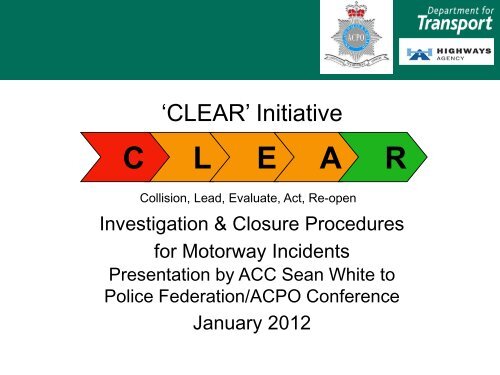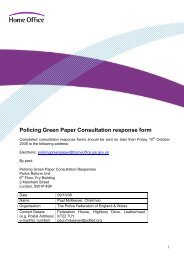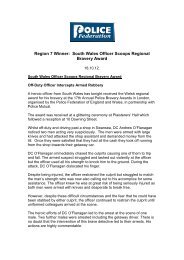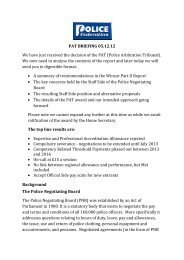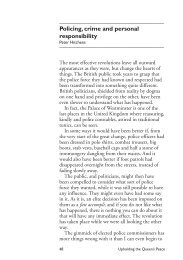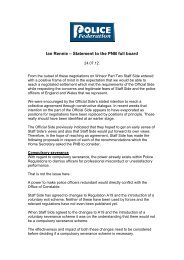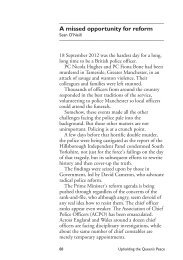'CLEAR' Initiative - Collision, Lead, Evaluate, Act ... - Police Federation
'CLEAR' Initiative - Collision, Lead, Evaluate, Act ... - Police Federation
'CLEAR' Initiative - Collision, Lead, Evaluate, Act ... - Police Federation
You also want an ePaper? Increase the reach of your titles
YUMPU automatically turns print PDFs into web optimized ePapers that Google loves.
C<br />
‘CLEAR’ <strong>Initiative</strong><br />
L E A<br />
R<br />
<strong>Collision</strong>, <strong>Lead</strong>, <strong>Evaluate</strong>, <strong>Act</strong>, Re-open<br />
Investigation & Closure Procedures<br />
for Motorway Incidents<br />
Presentation by ACC Sean White to<br />
<strong>Police</strong> <strong>Federation</strong>/ACPO Conference<br />
January 2012
Background<br />
• 19 May 2011: First Incident Management Summit<br />
- Chaired by Minister for Roads<br />
- Review into motorway closures & incident management published<br />
- 10 recommendations agreed and supported by the Minister<br />
• Review and subsequent programme of activity includes participation<br />
from:<br />
- Home Office; ACPO<br />
- DfT; Highways Agency<br />
- CFOA<br />
- AACE
Recommendations<br />
• 10<br />
recommendations<br />
• Covers a range of<br />
strategic, tactical<br />
and operational<br />
deliverables
Culmative Impact Duration (Hours)<br />
Further Analysis Work:<br />
Findings<br />
High number of short duration incidents<br />
combine to have a significant impact on<br />
traffic (industry and general) resulting in a<br />
high cost to the economy<br />
Less frequent, long duration<br />
incidents have a low economic cost<br />
but significant reputational impact<br />
Culmative Duration of Carriageway Impact Incidents (Motorways Only)<br />
Between 1st September 2010 and 31st August 2011<br />
40000<br />
35000<br />
30000<br />
25000<br />
20000<br />
15000<br />
10000<br />
5000<br />
0<br />
0-5 Hours 5-8 Hours 8-12 Hours 12 Hours +<br />
Carriageway Impact Duration<br />
Requires strong operational<br />
and tactical leadership as<br />
there is no/ little escalation<br />
Requires strong senior<br />
leadership to resolve multi<br />
responder incidents
Findings – Incident Types<br />
0-5 Hours<br />
5-8 Hours<br />
8-12 Hours<br />
12+ Hours<br />
86,480 Incidents<br />
302 Incidents<br />
136 Incidents<br />
68 Incidents<br />
30 Fatal<br />
600 serious<br />
8400 Slight<br />
47 Fatal<br />
59 Serious<br />
67 Slight<br />
23 Fatal<br />
30 Serious<br />
28 Slight<br />
10 Fatal<br />
5 Serious<br />
14 Slight<br />
Unknown % involving<br />
HGV<br />
Most Common<br />
Incident Types:<br />
Breakdown Live Lane<br />
Debris<br />
<strong>Collision</strong> – Damage<br />
Only<br />
54% involving HGV<br />
Most Common<br />
Incident Types:<br />
<strong>Collision</strong>s involving a<br />
HGV<br />
Vehicle Fire Involving<br />
HGV<br />
<strong>Collision</strong>s involving a car<br />
60% involving HGV<br />
Most Common<br />
Incident Types:<br />
Overturned HGV<br />
Barrier Repairs<br />
Vehicle Fire Involving<br />
HGV<br />
67% involving HGV<br />
Most Common<br />
Incident Types:<br />
Overturned HGV<br />
Vehicle Fire Involving<br />
HGV<br />
Spillage Involving<br />
HGV<br />
Road Traffic <strong>Collision</strong> -<br />
injury<br />
*Motorway network only: 01.09.10 to 31.08.11
Findings: Incident<br />
Management Lifecycle<br />
• More effective coordination needed between command structures (bronze,<br />
silver, gold)<br />
• Categorisation of incidents different between organisations – leads to<br />
different response levels<br />
• Initial understanding/information not always clear – leads to uncertainty over<br />
resources/equipment required (application of SAD CHALETS)<br />
• Not always one team with effective overall management of the incident from<br />
start to finish<br />
• No common shared objectives<br />
• Empowerment of those on the ground to have confidence to make timely<br />
and proportionate decisions (including investigation)<br />
• Understanding of investigation requirements between Coroner and the<br />
police<br />
• A better balance between safety and the ability to re-open a road needed<br />
for asset restoration - innovation
Conclusions<br />
• If we were to sum up the overriding theme from the<br />
analysis, it seems to point to the need for effective joint<br />
leadership, both in terms of management of the actual<br />
incident and leading a joint cultural change to:<br />
– Break down the boundaries across partnership working (where<br />
they exist ) to have a common shared goal and approach<br />
– Empowering/supporting individuals to have confidence to make<br />
timely and effective decisions; and<br />
– Strive for innovation in seeking to manage incidents better and<br />
smarter
Findings - Information<br />
• Good progress made on getting a clearer understanding of the<br />
issues<br />
• Effective media strategies and ‘talking heads’<br />
– Important to help manage public understanding and expectations<br />
of the incident<br />
• Credibility of VMS a key issue for road users in trusting information<br />
– Decisions around taking evasive action<br />
– Perception around what is happening
Solutions<br />
• HGV research (spill kits/fuel tanks) and prevention strategy<br />
• Develop options for innovation in asset restoration<br />
• <strong>Lead</strong>ership – identify actions to embed CLEAR principles amongst<br />
organisations:<br />
– Refresh/Re launch of joint incident MOU with joint objectives<br />
– Issue CLEAR booklet on roles and responsibilities<br />
• Procedures<br />
– Multi-organisational team in command structure<br />
– Harmonious incident categorisation<br />
– As part of RDIM review<br />
• Dynamic risk assessments<br />
• Investigate feasibility to collect evidence via other means i.e. CCTV, where<br />
appropriate<br />
• Investigate time boxing investigation
Solutions<br />
• Information<br />
– Develop common shared set of messages for responders to<br />
issue to the media<br />
– Investigate access/use of CCTV for responders to determine<br />
level of resource/equipment needed<br />
– HA already taking forward a number of information solutions and<br />
will also be developing:<br />
• Scrolling signs for trapped traffic<br />
• Improving messaging on VMS<br />
• Other <strong>Act</strong>ivities<br />
– Equipment bins<br />
– Trial of motorcycle retriever<br />
– Incident screens – reintroduction under consideration<br />
– HA Traffic Officer Service focused on live lane activity
Progress to Date – Other<br />
Recommendations<br />
• Roles & responsibilities: booklet & DVD<br />
• Capturing best practice & lessons: Debriefing & feed to <strong>Collision</strong><br />
Investigation publications<br />
• Sharing lessons and best practice: TIM Bulletin<br />
• Building skills and capabilities: Exercises<br />
• Review of the RDIM – <strong>Police</strong> have a responsibility to ensure road is<br />
reopened quickly<br />
• Laser Scanning £3m fund and bid process<br />
• Performance measurement & management: incident profiles (in<br />
development)
C<br />
‘CLEAR’ <strong>Initiative</strong><br />
L E A<br />
R<br />
<strong>Collision</strong>, <strong>Lead</strong>, <strong>Evaluate</strong>, <strong>Act</strong>, Re-open<br />
Investigation & Closure Procedures<br />
for Motorway Incidents<br />
Presentation by ACC Sean White to<br />
<strong>Police</strong> <strong>Federation</strong>/ACPO Conference<br />
January 2012


